Law and Negligence Act: Contractual and Tortious Liabilities Report
VerifiedAdded on 2020/01/07
|9
|2794
|146
Report
AI Summary
This report provides a detailed analysis of key aspects of law and negligence. It begins by exploring the essential elements of a valid contract, differentiating between unilateral and bilateral contracts, and examining the impact of various contract terms. The report then delves into case studies, illustrating elements of a contract in a business scenario, and analyzes relevant laws concerning contract terms, including implied terms, conditions, and warranties. Furthermore, it contrasts liabilities in tort and contractual liabilities, explaining the nature of liability in negligence and how a business can be vicariously liable. The report concludes with an examination of the elements of the tort of negligence, vicarious liability, and defenses in a given business situation, offering a comprehensive overview of the legal concepts discussed.
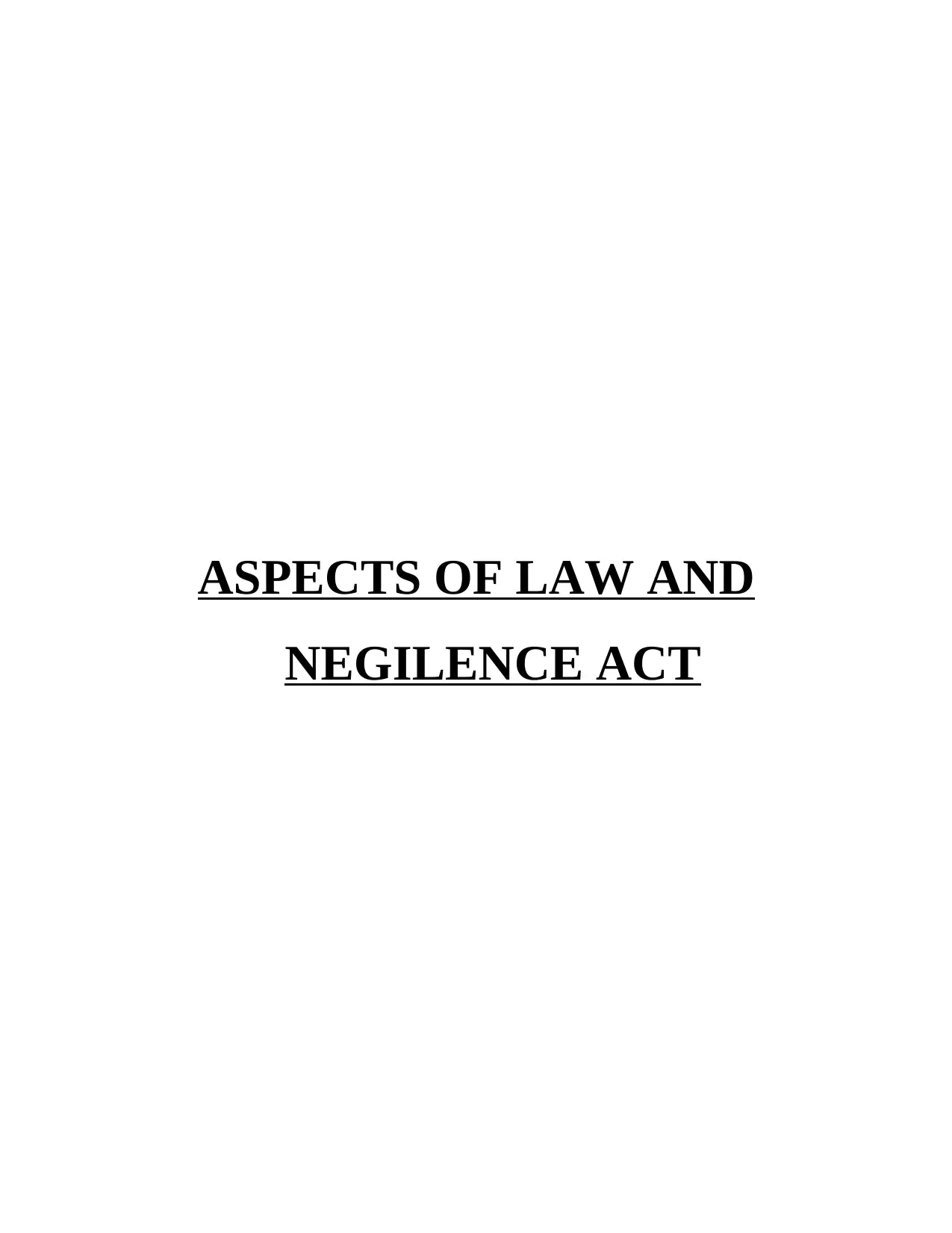
ASPECTS OF LAW AND
NEGILENCE ACT
NEGILENCE ACT
Paraphrase This Document
Need a fresh take? Get an instant paraphrase of this document with our AI Paraphraser
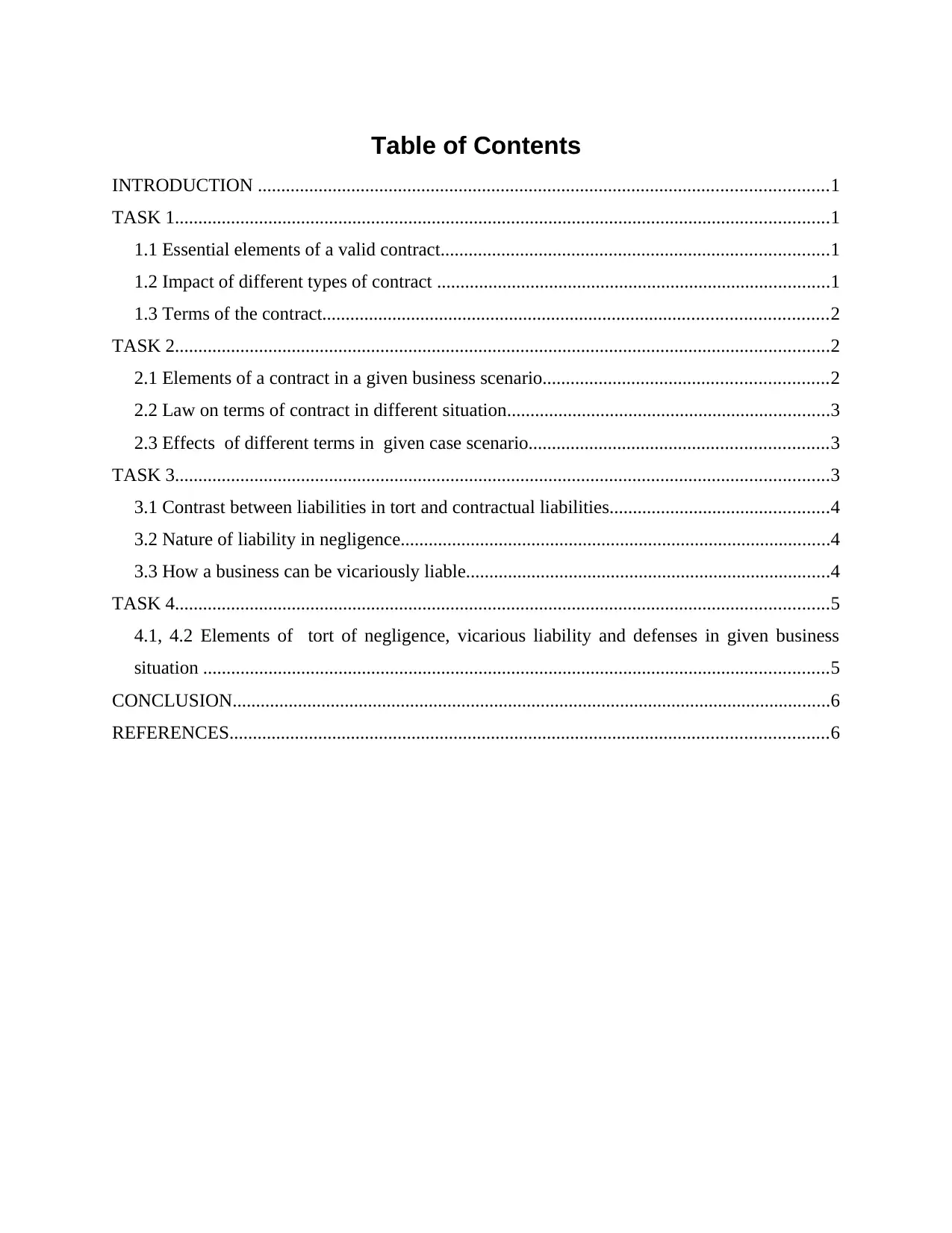
Table of Contents
INTRODUCTION ..........................................................................................................................1
TASK 1............................................................................................................................................1
1.1 Essential elements of a valid contract...................................................................................1
1.2 Impact of different types of contract ....................................................................................1
1.3 Terms of the contract............................................................................................................2
TASK 2............................................................................................................................................2
2.1 Elements of a contract in a given business scenario.............................................................2
2.2 Law on terms of contract in different situation.....................................................................3
2.3 Effects of different terms in given case scenario................................................................3
TASK 3............................................................................................................................................3
3.1 Contrast between liabilities in tort and contractual liabilities...............................................4
3.2 Nature of liability in negligence............................................................................................4
3.3 How a business can be vicariously liable..............................................................................4
TASK 4............................................................................................................................................5
4.1, 4.2 Elements of tort of negligence, vicarious liability and defenses in given business
situation ......................................................................................................................................5
CONCLUSION................................................................................................................................6
REFERENCES................................................................................................................................6
INTRODUCTION ..........................................................................................................................1
TASK 1............................................................................................................................................1
1.1 Essential elements of a valid contract...................................................................................1
1.2 Impact of different types of contract ....................................................................................1
1.3 Terms of the contract............................................................................................................2
TASK 2............................................................................................................................................2
2.1 Elements of a contract in a given business scenario.............................................................2
2.2 Law on terms of contract in different situation.....................................................................3
2.3 Effects of different terms in given case scenario................................................................3
TASK 3............................................................................................................................................3
3.1 Contrast between liabilities in tort and contractual liabilities...............................................4
3.2 Nature of liability in negligence............................................................................................4
3.3 How a business can be vicariously liable..............................................................................4
TASK 4............................................................................................................................................5
4.1, 4.2 Elements of tort of negligence, vicarious liability and defenses in given business
situation ......................................................................................................................................5
CONCLUSION................................................................................................................................6
REFERENCES................................................................................................................................6
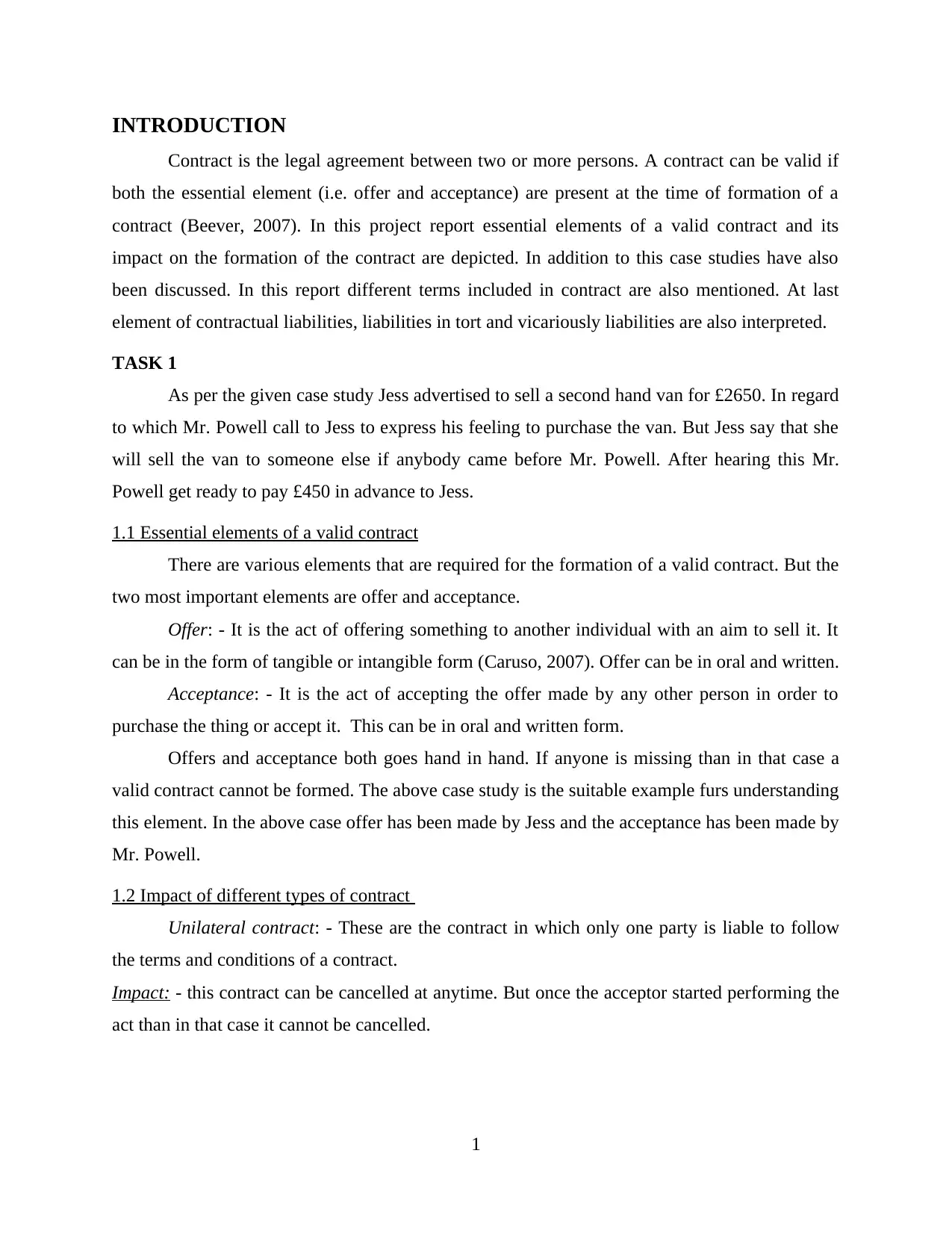
INTRODUCTION
Contract is the legal agreement between two or more persons. A contract can be valid if
both the essential element (i.e. offer and acceptance) are present at the time of formation of a
contract (Beever, 2007). In this project report essential elements of a valid contract and its
impact on the formation of the contract are depicted. In addition to this case studies have also
been discussed. In this report different terms included in contract are also mentioned. At last
element of contractual liabilities, liabilities in tort and vicariously liabilities are also interpreted.
TASK 1
As per the given case study Jess advertised to sell a second hand van for £2650. In regard
to which Mr. Powell call to Jess to express his feeling to purchase the van. But Jess say that she
will sell the van to someone else if anybody came before Mr. Powell. After hearing this Mr.
Powell get ready to pay £450 in advance to Jess.
1.1 Essential elements of a valid contract
There are various elements that are required for the formation of a valid contract. But the
two most important elements are offer and acceptance.
Offer: - It is the act of offering something to another individual with an aim to sell it. It
can be in the form of tangible or intangible form (Caruso, 2007). Offer can be in oral and written.
Acceptance: - It is the act of accepting the offer made by any other person in order to
purchase the thing or accept it. This can be in oral and written form.
Offers and acceptance both goes hand in hand. If anyone is missing than in that case a
valid contract cannot be formed. The above case study is the suitable example furs understanding
this element. In the above case offer has been made by Jess and the acceptance has been made by
Mr. Powell.
1.2 Impact of different types of contract
Unilateral contract: - These are the contract in which only one party is liable to follow
the terms and conditions of a contract.
Impact: - this contract can be cancelled at anytime. But once the acceptor started performing the
act than in that case it cannot be cancelled.
1
Contract is the legal agreement between two or more persons. A contract can be valid if
both the essential element (i.e. offer and acceptance) are present at the time of formation of a
contract (Beever, 2007). In this project report essential elements of a valid contract and its
impact on the formation of the contract are depicted. In addition to this case studies have also
been discussed. In this report different terms included in contract are also mentioned. At last
element of contractual liabilities, liabilities in tort and vicariously liabilities are also interpreted.
TASK 1
As per the given case study Jess advertised to sell a second hand van for £2650. In regard
to which Mr. Powell call to Jess to express his feeling to purchase the van. But Jess say that she
will sell the van to someone else if anybody came before Mr. Powell. After hearing this Mr.
Powell get ready to pay £450 in advance to Jess.
1.1 Essential elements of a valid contract
There are various elements that are required for the formation of a valid contract. But the
two most important elements are offer and acceptance.
Offer: - It is the act of offering something to another individual with an aim to sell it. It
can be in the form of tangible or intangible form (Caruso, 2007). Offer can be in oral and written.
Acceptance: - It is the act of accepting the offer made by any other person in order to
purchase the thing or accept it. This can be in oral and written form.
Offers and acceptance both goes hand in hand. If anyone is missing than in that case a
valid contract cannot be formed. The above case study is the suitable example furs understanding
this element. In the above case offer has been made by Jess and the acceptance has been made by
Mr. Powell.
1.2 Impact of different types of contract
Unilateral contract: - These are the contract in which only one party is liable to follow
the terms and conditions of a contract.
Impact: - this contract can be cancelled at anytime. But once the acceptor started performing the
act than in that case it cannot be cancelled.
1
⊘ This is a preview!⊘
Do you want full access?
Subscribe today to unlock all pages.

Trusted by 1+ million students worldwide
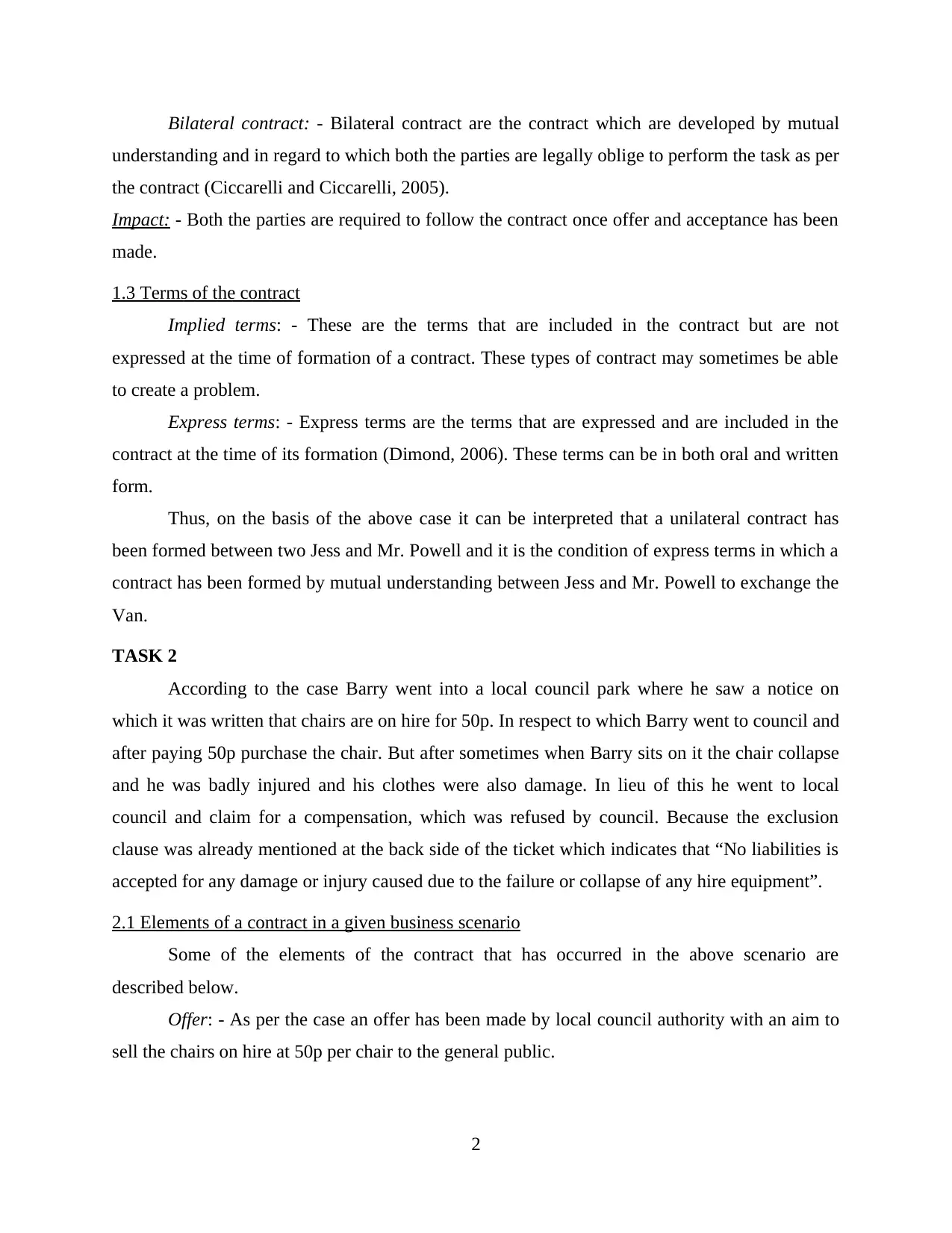
Bilateral contract: - Bilateral contract are the contract which are developed by mutual
understanding and in regard to which both the parties are legally oblige to perform the task as per
the contract (Ciccarelli and Ciccarelli, 2005).
Impact: - Both the parties are required to follow the contract once offer and acceptance has been
made.
1.3 Terms of the contract
Implied terms: - These are the terms that are included in the contract but are not
expressed at the time of formation of a contract. These types of contract may sometimes be able
to create a problem.
Express terms: - Express terms are the terms that are expressed and are included in the
contract at the time of its formation (Dimond, 2006). These terms can be in both oral and written
form.
Thus, on the basis of the above case it can be interpreted that a unilateral contract has
been formed between two Jess and Mr. Powell and it is the condition of express terms in which a
contract has been formed by mutual understanding between Jess and Mr. Powell to exchange the
Van.
TASK 2
According to the case Barry went into a local council park where he saw a notice on
which it was written that chairs are on hire for 50p. In respect to which Barry went to council and
after paying 50p purchase the chair. But after sometimes when Barry sits on it the chair collapse
and he was badly injured and his clothes were also damage. In lieu of this he went to local
council and claim for a compensation, which was refused by council. Because the exclusion
clause was already mentioned at the back side of the ticket which indicates that “No liabilities is
accepted for any damage or injury caused due to the failure or collapse of any hire equipment”.
2.1 Elements of a contract in a given business scenario
Some of the elements of the contract that has occurred in the above scenario are
described below.
Offer: - As per the case an offer has been made by local council authority with an aim to
sell the chairs on hire at 50p per chair to the general public.
2
understanding and in regard to which both the parties are legally oblige to perform the task as per
the contract (Ciccarelli and Ciccarelli, 2005).
Impact: - Both the parties are required to follow the contract once offer and acceptance has been
made.
1.3 Terms of the contract
Implied terms: - These are the terms that are included in the contract but are not
expressed at the time of formation of a contract. These types of contract may sometimes be able
to create a problem.
Express terms: - Express terms are the terms that are expressed and are included in the
contract at the time of its formation (Dimond, 2006). These terms can be in both oral and written
form.
Thus, on the basis of the above case it can be interpreted that a unilateral contract has
been formed between two Jess and Mr. Powell and it is the condition of express terms in which a
contract has been formed by mutual understanding between Jess and Mr. Powell to exchange the
Van.
TASK 2
According to the case Barry went into a local council park where he saw a notice on
which it was written that chairs are on hire for 50p. In respect to which Barry went to council and
after paying 50p purchase the chair. But after sometimes when Barry sits on it the chair collapse
and he was badly injured and his clothes were also damage. In lieu of this he went to local
council and claim for a compensation, which was refused by council. Because the exclusion
clause was already mentioned at the back side of the ticket which indicates that “No liabilities is
accepted for any damage or injury caused due to the failure or collapse of any hire equipment”.
2.1 Elements of a contract in a given business scenario
Some of the elements of the contract that has occurred in the above scenario are
described below.
Offer: - As per the case an offer has been made by local council authority with an aim to
sell the chairs on hire at 50p per chair to the general public.
2
Paraphrase This Document
Need a fresh take? Get an instant paraphrase of this document with our AI Paraphraser
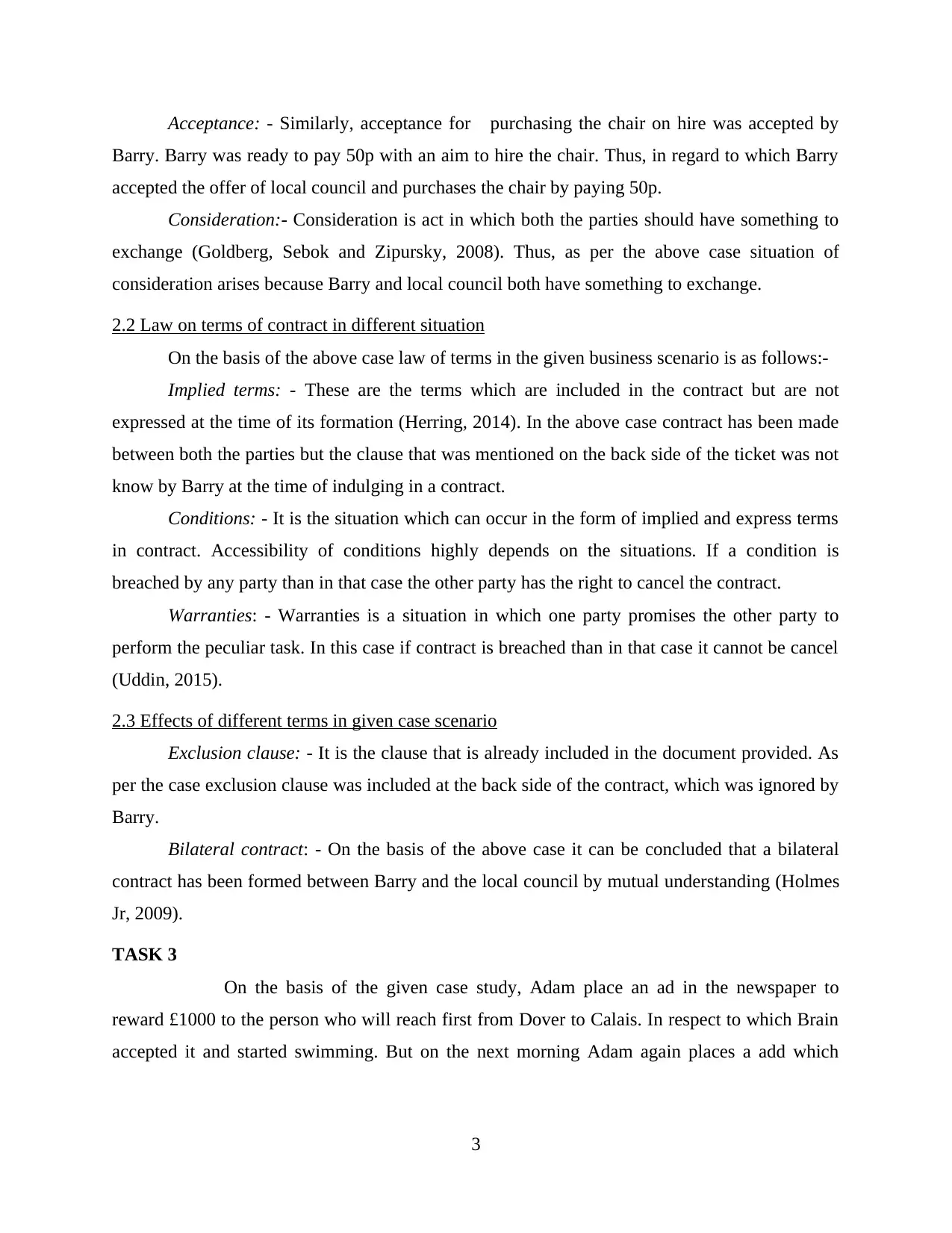
Acceptance: - Similarly, acceptance for purchasing the chair on hire was accepted by
Barry. Barry was ready to pay 50p with an aim to hire the chair. Thus, in regard to which Barry
accepted the offer of local council and purchases the chair by paying 50p.
Consideration:- Consideration is act in which both the parties should have something to
exchange (Goldberg, Sebok and Zipursky, 2008). Thus, as per the above case situation of
consideration arises because Barry and local council both have something to exchange.
2.2 Law on terms of contract in different situation
On the basis of the above case law of terms in the given business scenario is as follows:-
Implied terms: - These are the terms which are included in the contract but are not
expressed at the time of its formation (Herring, 2014). In the above case contract has been made
between both the parties but the clause that was mentioned on the back side of the ticket was not
know by Barry at the time of indulging in a contract.
Conditions: - It is the situation which can occur in the form of implied and express terms
in contract. Accessibility of conditions highly depends on the situations. If a condition is
breached by any party than in that case the other party has the right to cancel the contract.
Warranties: - Warranties is a situation in which one party promises the other party to
perform the peculiar task. In this case if contract is breached than in that case it cannot be cancel
(Uddin, 2015).
2.3 Effects of different terms in given case scenario
Exclusion clause: - It is the clause that is already included in the document provided. As
per the case exclusion clause was included at the back side of the contract, which was ignored by
Barry.
Bilateral contract: - On the basis of the above case it can be concluded that a bilateral
contract has been formed between Barry and the local council by mutual understanding (Holmes
Jr, 2009).
TASK 3
On the basis of the given case study, Adam place an ad in the newspaper to
reward £1000 to the person who will reach first from Dover to Calais. In respect to which Brain
accepted it and started swimming. But on the next morning Adam again places a add which
3
Barry. Barry was ready to pay 50p with an aim to hire the chair. Thus, in regard to which Barry
accepted the offer of local council and purchases the chair by paying 50p.
Consideration:- Consideration is act in which both the parties should have something to
exchange (Goldberg, Sebok and Zipursky, 2008). Thus, as per the above case situation of
consideration arises because Barry and local council both have something to exchange.
2.2 Law on terms of contract in different situation
On the basis of the above case law of terms in the given business scenario is as follows:-
Implied terms: - These are the terms which are included in the contract but are not
expressed at the time of its formation (Herring, 2014). In the above case contract has been made
between both the parties but the clause that was mentioned on the back side of the ticket was not
know by Barry at the time of indulging in a contract.
Conditions: - It is the situation which can occur in the form of implied and express terms
in contract. Accessibility of conditions highly depends on the situations. If a condition is
breached by any party than in that case the other party has the right to cancel the contract.
Warranties: - Warranties is a situation in which one party promises the other party to
perform the peculiar task. In this case if contract is breached than in that case it cannot be cancel
(Uddin, 2015).
2.3 Effects of different terms in given case scenario
Exclusion clause: - It is the clause that is already included in the document provided. As
per the case exclusion clause was included at the back side of the contract, which was ignored by
Barry.
Bilateral contract: - On the basis of the above case it can be concluded that a bilateral
contract has been formed between Barry and the local council by mutual understanding (Holmes
Jr, 2009).
TASK 3
On the basis of the given case study, Adam place an ad in the newspaper to
reward £1000 to the person who will reach first from Dover to Calais. In respect to which Brain
accepted it and started swimming. But on the next morning Adam again places a add which
3
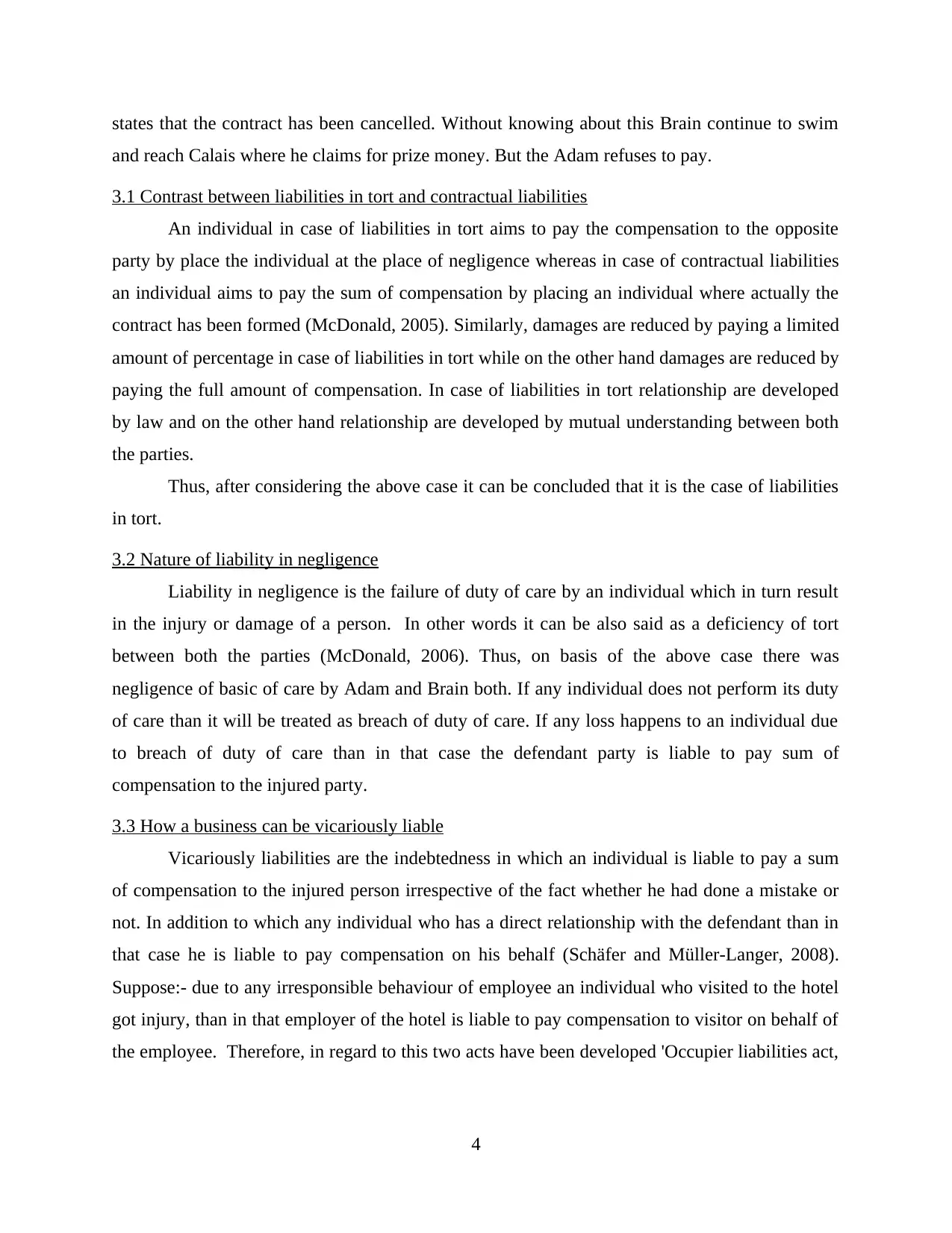
states that the contract has been cancelled. Without knowing about this Brain continue to swim
and reach Calais where he claims for prize money. But the Adam refuses to pay.
3.1 Contrast between liabilities in tort and contractual liabilities
An individual in case of liabilities in tort aims to pay the compensation to the opposite
party by place the individual at the place of negligence whereas in case of contractual liabilities
an individual aims to pay the sum of compensation by placing an individual where actually the
contract has been formed (McDonald, 2005). Similarly, damages are reduced by paying a limited
amount of percentage in case of liabilities in tort while on the other hand damages are reduced by
paying the full amount of compensation. In case of liabilities in tort relationship are developed
by law and on the other hand relationship are developed by mutual understanding between both
the parties.
Thus, after considering the above case it can be concluded that it is the case of liabilities
in tort.
3.2 Nature of liability in negligence
Liability in negligence is the failure of duty of care by an individual which in turn result
in the injury or damage of a person. In other words it can be also said as a deficiency of tort
between both the parties (McDonald, 2006). Thus, on basis of the above case there was
negligence of basic of care by Adam and Brain both. If any individual does not perform its duty
of care than it will be treated as breach of duty of care. If any loss happens to an individual due
to breach of duty of care than in that case the defendant party is liable to pay sum of
compensation to the injured party.
3.3 How a business can be vicariously liable
Vicariously liabilities are the indebtedness in which an individual is liable to pay a sum
of compensation to the injured person irrespective of the fact whether he had done a mistake or
not. In addition to which any individual who has a direct relationship with the defendant than in
that case he is liable to pay compensation on his behalf (Schäfer and Müller-Langer, 2008).
Suppose:- due to any irresponsible behaviour of employee an individual who visited to the hotel
got injury, than in that employer of the hotel is liable to pay compensation to visitor on behalf of
the employee. Therefore, in regard to this two acts have been developed 'Occupier liabilities act,
4
and reach Calais where he claims for prize money. But the Adam refuses to pay.
3.1 Contrast between liabilities in tort and contractual liabilities
An individual in case of liabilities in tort aims to pay the compensation to the opposite
party by place the individual at the place of negligence whereas in case of contractual liabilities
an individual aims to pay the sum of compensation by placing an individual where actually the
contract has been formed (McDonald, 2005). Similarly, damages are reduced by paying a limited
amount of percentage in case of liabilities in tort while on the other hand damages are reduced by
paying the full amount of compensation. In case of liabilities in tort relationship are developed
by law and on the other hand relationship are developed by mutual understanding between both
the parties.
Thus, after considering the above case it can be concluded that it is the case of liabilities
in tort.
3.2 Nature of liability in negligence
Liability in negligence is the failure of duty of care by an individual which in turn result
in the injury or damage of a person. In other words it can be also said as a deficiency of tort
between both the parties (McDonald, 2006). Thus, on basis of the above case there was
negligence of basic of care by Adam and Brain both. If any individual does not perform its duty
of care than it will be treated as breach of duty of care. If any loss happens to an individual due
to breach of duty of care than in that case the defendant party is liable to pay sum of
compensation to the injured party.
3.3 How a business can be vicariously liable
Vicariously liabilities are the indebtedness in which an individual is liable to pay a sum
of compensation to the injured person irrespective of the fact whether he had done a mistake or
not. In addition to which any individual who has a direct relationship with the defendant than in
that case he is liable to pay compensation on his behalf (Schäfer and Müller-Langer, 2008).
Suppose:- due to any irresponsible behaviour of employee an individual who visited to the hotel
got injury, than in that employer of the hotel is liable to pay compensation to visitor on behalf of
the employee. Therefore, in regard to this two acts have been developed 'Occupier liabilities act,
4
⊘ This is a preview!⊘
Do you want full access?
Subscribe today to unlock all pages.

Trusted by 1+ million students worldwide
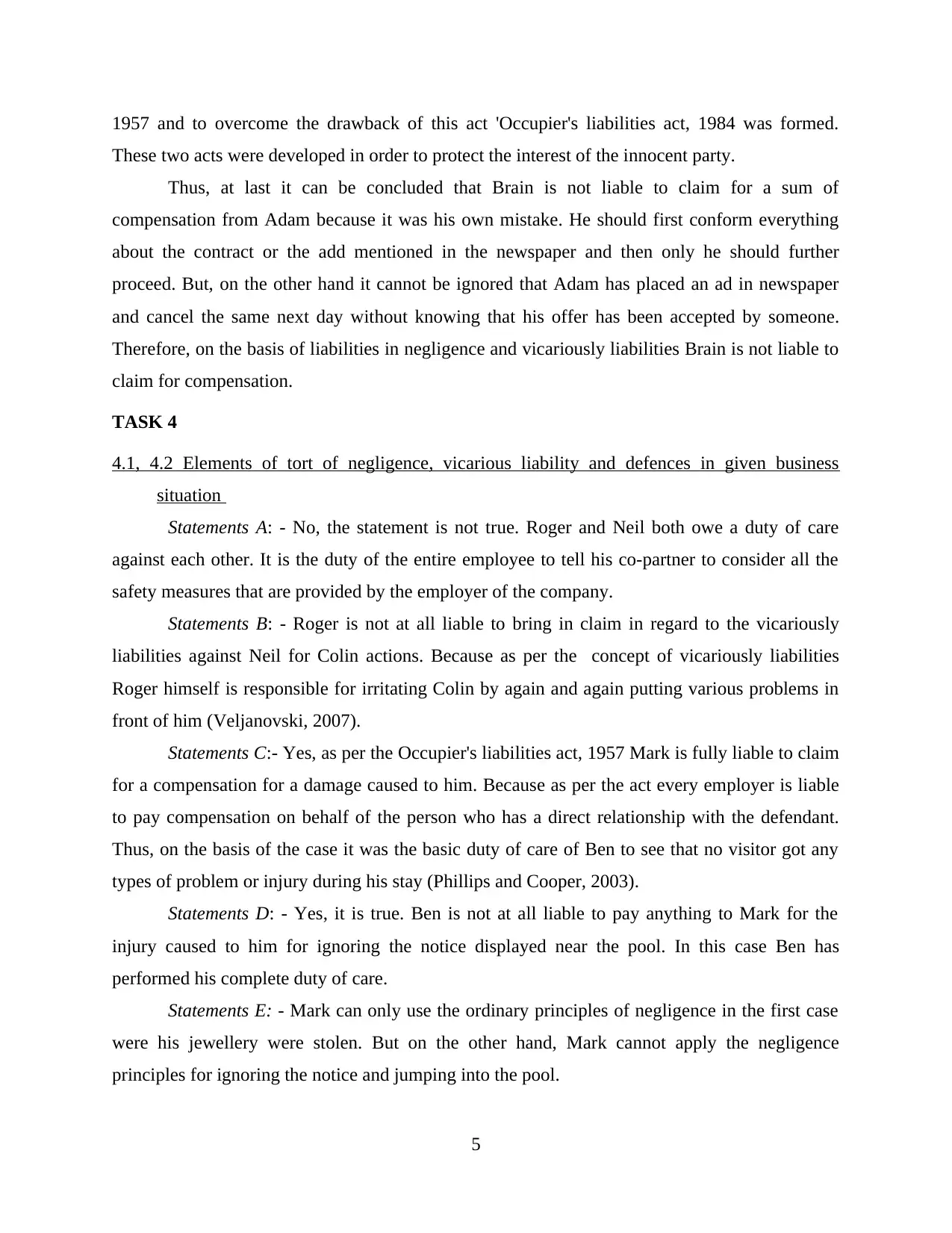
1957 and to overcome the drawback of this act 'Occupier's liabilities act, 1984 was formed.
These two acts were developed in order to protect the interest of the innocent party.
Thus, at last it can be concluded that Brain is not liable to claim for a sum of
compensation from Adam because it was his own mistake. He should first conform everything
about the contract or the add mentioned in the newspaper and then only he should further
proceed. But, on the other hand it cannot be ignored that Adam has placed an ad in newspaper
and cancel the same next day without knowing that his offer has been accepted by someone.
Therefore, on the basis of liabilities in negligence and vicariously liabilities Brain is not liable to
claim for compensation.
TASK 4
4.1, 4.2 Elements of tort of negligence, vicarious liability and defences in given business
situation
Statements A: - No, the statement is not true. Roger and Neil both owe a duty of care
against each other. It is the duty of the entire employee to tell his co-partner to consider all the
safety measures that are provided by the employer of the company.
Statements B: - Roger is not at all liable to bring in claim in regard to the vicariously
liabilities against Neil for Colin actions. Because as per the concept of vicariously liabilities
Roger himself is responsible for irritating Colin by again and again putting various problems in
front of him (Veljanovski, 2007).
Statements C:- Yes, as per the Occupier's liabilities act, 1957 Mark is fully liable to claim
for a compensation for a damage caused to him. Because as per the act every employer is liable
to pay compensation on behalf of the person who has a direct relationship with the defendant.
Thus, on the basis of the case it was the basic duty of care of Ben to see that no visitor got any
types of problem or injury during his stay (Phillips and Cooper, 2003).
Statements D: - Yes, it is true. Ben is not at all liable to pay anything to Mark for the
injury caused to him for ignoring the notice displayed near the pool. In this case Ben has
performed his complete duty of care.
Statements E: - Mark can only use the ordinary principles of negligence in the first case
were his jewellery were stolen. But on the other hand, Mark cannot apply the negligence
principles for ignoring the notice and jumping into the pool.
5
These two acts were developed in order to protect the interest of the innocent party.
Thus, at last it can be concluded that Brain is not liable to claim for a sum of
compensation from Adam because it was his own mistake. He should first conform everything
about the contract or the add mentioned in the newspaper and then only he should further
proceed. But, on the other hand it cannot be ignored that Adam has placed an ad in newspaper
and cancel the same next day without knowing that his offer has been accepted by someone.
Therefore, on the basis of liabilities in negligence and vicariously liabilities Brain is not liable to
claim for compensation.
TASK 4
4.1, 4.2 Elements of tort of negligence, vicarious liability and defences in given business
situation
Statements A: - No, the statement is not true. Roger and Neil both owe a duty of care
against each other. It is the duty of the entire employee to tell his co-partner to consider all the
safety measures that are provided by the employer of the company.
Statements B: - Roger is not at all liable to bring in claim in regard to the vicariously
liabilities against Neil for Colin actions. Because as per the concept of vicariously liabilities
Roger himself is responsible for irritating Colin by again and again putting various problems in
front of him (Veljanovski, 2007).
Statements C:- Yes, as per the Occupier's liabilities act, 1957 Mark is fully liable to claim
for a compensation for a damage caused to him. Because as per the act every employer is liable
to pay compensation on behalf of the person who has a direct relationship with the defendant.
Thus, on the basis of the case it was the basic duty of care of Ben to see that no visitor got any
types of problem or injury during his stay (Phillips and Cooper, 2003).
Statements D: - Yes, it is true. Ben is not at all liable to pay anything to Mark for the
injury caused to him for ignoring the notice displayed near the pool. In this case Ben has
performed his complete duty of care.
Statements E: - Mark can only use the ordinary principles of negligence in the first case
were his jewellery were stolen. But on the other hand, Mark cannot apply the negligence
principles for ignoring the notice and jumping into the pool.
5
Paraphrase This Document
Need a fresh take? Get an instant paraphrase of this document with our AI Paraphraser
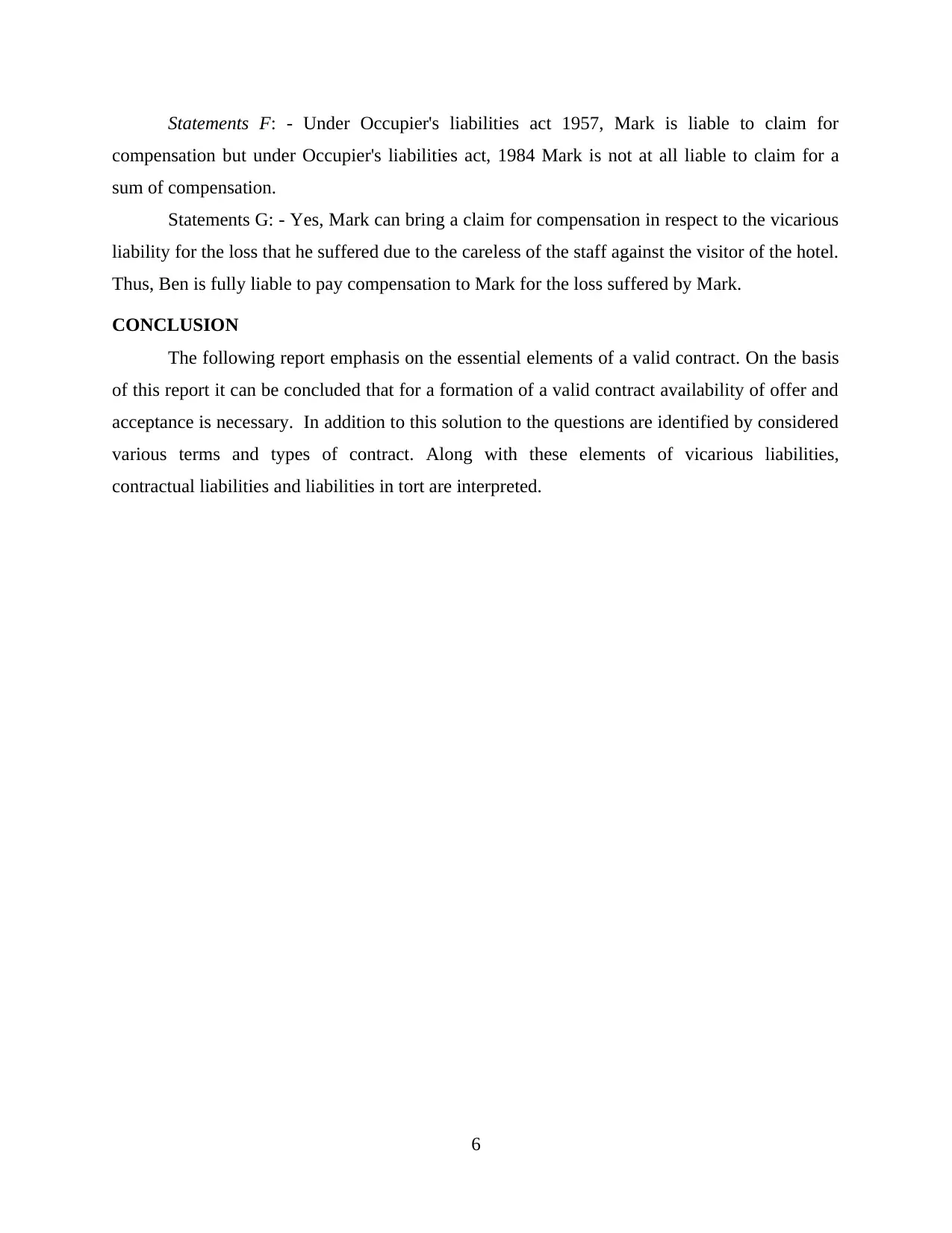
Statements F: - Under Occupier's liabilities act 1957, Mark is liable to claim for
compensation but under Occupier's liabilities act, 1984 Mark is not at all liable to claim for a
sum of compensation.
Statements G: - Yes, Mark can bring a claim for compensation in respect to the vicarious
liability for the loss that he suffered due to the careless of the staff against the visitor of the hotel.
Thus, Ben is fully liable to pay compensation to Mark for the loss suffered by Mark.
CONCLUSION
The following report emphasis on the essential elements of a valid contract. On the basis
of this report it can be concluded that for a formation of a valid contract availability of offer and
acceptance is necessary. In addition to this solution to the questions are identified by considered
various terms and types of contract. Along with these elements of vicarious liabilities,
contractual liabilities and liabilities in tort are interpreted.
6
compensation but under Occupier's liabilities act, 1984 Mark is not at all liable to claim for a
sum of compensation.
Statements G: - Yes, Mark can bring a claim for compensation in respect to the vicarious
liability for the loss that he suffered due to the careless of the staff against the visitor of the hotel.
Thus, Ben is fully liable to pay compensation to Mark for the loss suffered by Mark.
CONCLUSION
The following report emphasis on the essential elements of a valid contract. On the basis
of this report it can be concluded that for a formation of a valid contract availability of offer and
acceptance is necessary. In addition to this solution to the questions are identified by considered
various terms and types of contract. Along with these elements of vicarious liabilities,
contractual liabilities and liabilities in tort are interpreted.
6
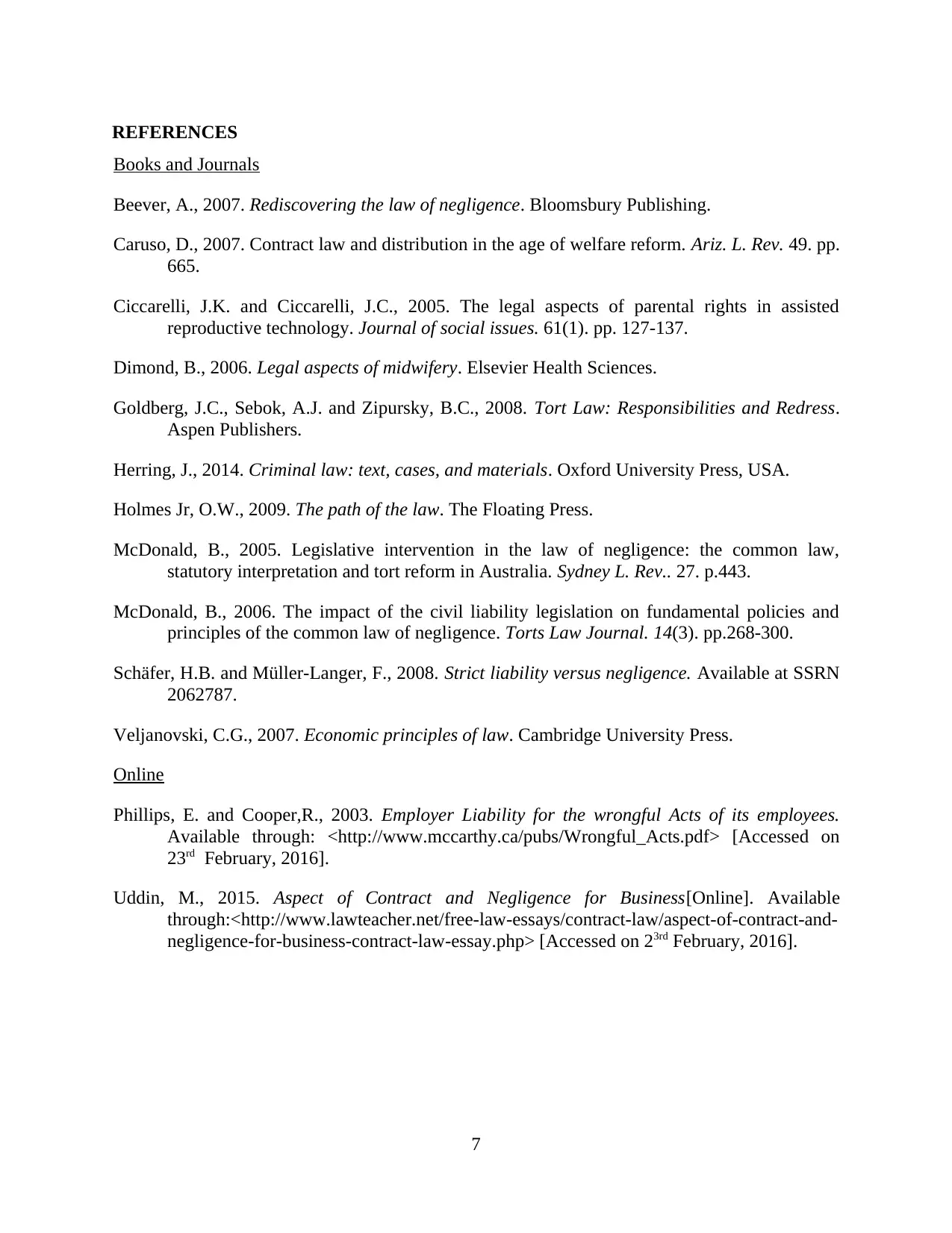
REFERENCES
Books and Journals
Beever, A., 2007. Rediscovering the law of negligence. Bloomsbury Publishing.
Caruso, D., 2007. Contract law and distribution in the age of welfare reform. Ariz. L. Rev. 49. pp.
665.
Ciccarelli, J.K. and Ciccarelli, J.C., 2005. The legal aspects of parental rights in assisted
reproductive technology. Journal of social issues. 61(1). pp. 127-137.
Dimond, B., 2006. Legal aspects of midwifery. Elsevier Health Sciences.
Goldberg, J.C., Sebok, A.J. and Zipursky, B.C., 2008. Tort Law: Responsibilities and Redress.
Aspen Publishers.
Herring, J., 2014. Criminal law: text, cases, and materials. Oxford University Press, USA.
Holmes Jr, O.W., 2009. The path of the law. The Floating Press.
McDonald, B., 2005. Legislative intervention in the law of negligence: the common law,
statutory interpretation and tort reform in Australia. Sydney L. Rev.. 27. p.443.
McDonald, B., 2006. The impact of the civil liability legislation on fundamental policies and
principles of the common law of negligence. Torts Law Journal. 14(3). pp.268-300.
Schäfer, H.B. and Müller-Langer, F., 2008. Strict liability versus negligence. Available at SSRN
2062787.
Veljanovski, C.G., 2007. Economic principles of law. Cambridge University Press.
Online
Phillips, E. and Cooper,R., 2003. Employer Liability for the wrongful Acts of its employees.
Available through: <http://www.mccarthy.ca/pubs/Wrongful_Acts.pdf> [Accessed on
23rd February, 2016].
Uddin, M., 2015. Aspect of Contract and Negligence for Business[Online]. Available
through:<http://www.lawteacher.net/free-law-essays/contract-law/aspect-of-contract-and-
negligence-for-business-contract-law-essay.php> [Accessed on 23rd February, 2016].
7
Books and Journals
Beever, A., 2007. Rediscovering the law of negligence. Bloomsbury Publishing.
Caruso, D., 2007. Contract law and distribution in the age of welfare reform. Ariz. L. Rev. 49. pp.
665.
Ciccarelli, J.K. and Ciccarelli, J.C., 2005. The legal aspects of parental rights in assisted
reproductive technology. Journal of social issues. 61(1). pp. 127-137.
Dimond, B., 2006. Legal aspects of midwifery. Elsevier Health Sciences.
Goldberg, J.C., Sebok, A.J. and Zipursky, B.C., 2008. Tort Law: Responsibilities and Redress.
Aspen Publishers.
Herring, J., 2014. Criminal law: text, cases, and materials. Oxford University Press, USA.
Holmes Jr, O.W., 2009. The path of the law. The Floating Press.
McDonald, B., 2005. Legislative intervention in the law of negligence: the common law,
statutory interpretation and tort reform in Australia. Sydney L. Rev.. 27. p.443.
McDonald, B., 2006. The impact of the civil liability legislation on fundamental policies and
principles of the common law of negligence. Torts Law Journal. 14(3). pp.268-300.
Schäfer, H.B. and Müller-Langer, F., 2008. Strict liability versus negligence. Available at SSRN
2062787.
Veljanovski, C.G., 2007. Economic principles of law. Cambridge University Press.
Online
Phillips, E. and Cooper,R., 2003. Employer Liability for the wrongful Acts of its employees.
Available through: <http://www.mccarthy.ca/pubs/Wrongful_Acts.pdf> [Accessed on
23rd February, 2016].
Uddin, M., 2015. Aspect of Contract and Negligence for Business[Online]. Available
through:<http://www.lawteacher.net/free-law-essays/contract-law/aspect-of-contract-and-
negligence-for-business-contract-law-essay.php> [Accessed on 23rd February, 2016].
7
⊘ This is a preview!⊘
Do you want full access?
Subscribe today to unlock all pages.

Trusted by 1+ million students worldwide
1 out of 9
Related Documents
Your All-in-One AI-Powered Toolkit for Academic Success.
+13062052269
info@desklib.com
Available 24*7 on WhatsApp / Email
![[object Object]](/_next/static/media/star-bottom.7253800d.svg)
Unlock your academic potential
Copyright © 2020–2025 A2Z Services. All Rights Reserved. Developed and managed by ZUCOL.




![Analysis of Contract and Tort Law in Business Context - [Module Name]](/_next/image/?url=https%3A%2F%2Fdesklib.com%2Fmedia%2Fimages%2Fb4a2ce2d00e84688b846acd1edfd5492.jpg&w=256&q=75)
